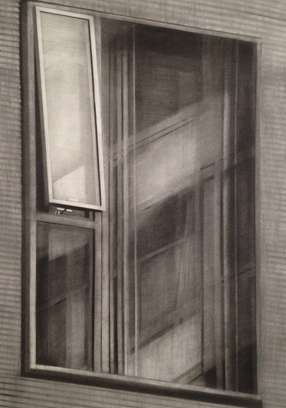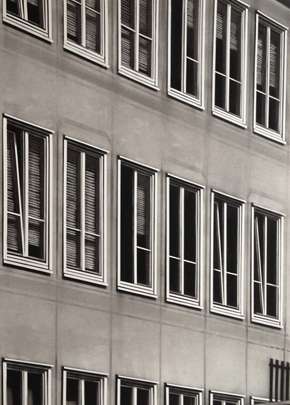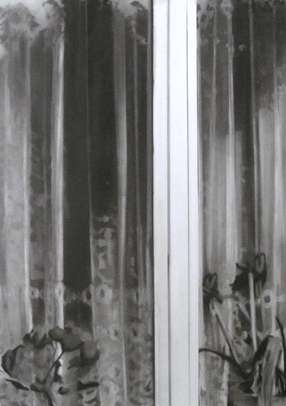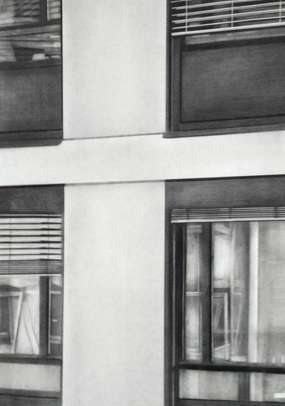Jonathan Meades
Jonathan Meades on Jargon
(irrelevant image)
Ed Atkins - Olde Food
research no.2
Tumblr.
email:
the.edge.b223@gmail.com
password:
ualchelsea2019!
11.11.2019
'spacial displacement' :
Je, tu, il, elle (1974)
The commas in the title suggest corporeal and spatial displacement, and this becomes the subject of Akerman’s narrative triptych. In intimate but enervating encounters, the director-actor attempts to locate a meaning in routine – first an insistence upon it, and then a decisive break. Made after her return from New York, it’s Akerman’s most affecting study of the self, particularly devastating because her on-screen persona’s attempt at emancipation only exacerbates the rootless, shifting ennui that haunts her. The first lines, “and then I left”, could just as well be its last.
'The Art of Light and Space'
p8 (introduction)
Retinal Replay Volume in Works in Spaces (san francisco museum of ..) Robert Irwin P29
P23 Fractured Light - Partial Scrim Ceiling - Eye-Level Wire
'... comprised only the barest and least substantial materials, such as string, scrim, and what Irwin calls "givens" - light, space, ambience. ... the shape and presence of these pieces varies .......
P29
P33
'from dawn to dusk'
how far the light could go , through different material onto the wall , does it mean an end ?
P163
Eric Orr
"gradually almost imperceptibly, the room began to lighten, and so did my fear...."
+'fear itself'
dark space when the light coming lighter , narrower from the normal view point
notes
memories
time
changes
what is the chemical changes of the matter - eg. film
noise music
david lynch (inland empire)
stop motion animation
process of changes (cheese plant)
sound recording - rain / ...... layers together , one top over each as susan hiller's film ? silence then loud ? words but you can't hear clearly what the narrative is about ? narratives - lots of stories , thoughts , fragmentations ..
how the words affect experience ? - sound - distorted words
light
James Turrell
ambien sound
Brian Eno
colours
psychological lighting theory
r- thoughts
dbt . (continues) . the function of remembering . photos ? if film is also not the 'right answer ? memories - fabricated past - should (?) "is" not be real , archive - wrong . writings is wrong itself - interindividual differences - right medium ? . filtered imagination - fantasy , dark space , distance , disgust is real . (different time zones) .
'not understanding adds to a pleasure' 'but in the depths of my heart , i'm happy' mmm ..... time . (again) . the only moment you have is now . sleep . well . (not yet) . workload . active .
+ Interindividual differences in perception describes the effect that differences in brain structure or factors such as culture, upbringing and environment have on the perception of humans. Interindividual (differing from person to person) variability is usually regarded as a source of noise for research.
'egg (church) and the snake' - back to Breton (bath tub - Bathes) - poeme objet . back to where it all begins (began) -
egg is the core , what's inside ? dialogues about the egg (eggs) , from egg white to meringue , 'cratylus' - talk - crack eggs for some cakes ? food processing , time ..
cracking /
transformation :
'storage memory' (christian.b) , lighting bolts , neurons (i'm back) , wires me up , focus , brain i can feel you .. peace .
what's the connection between an egg and m neurons ? brain = egg .. 'can conflict be fruitful' ? neurons = strings (metal wires) . shock (ECT) - circulatory system ..
snow white , back to white , egg . (sun inside - life) . heat . reflex . electric neurons , aha .. connections .. thank you reflexes (reflections) lively brain .. water , drink , automatic (calling) . ring . dust . 'the observer's book of weather' , growing . back again . circular . egg is whole .?
a cant (code - cryptolect) .
situation aesthetics . experience . enter if you cant see .
'associations' with john smiths , writings to the value of an egg ('oeuvre' / 'oeuf') , text to text ? work to work , stage presenting lindsay seers's 'care(less)' .. what is the actual thing ? condense the time , physicality , post structuralism with the mice running further out directions , word maze , approaching to the sounds , rain the train , through the mist .. darkroom processing , where's the light , where's the index , what are they ? sculpting the film , it's a guessing game . an egg , 'œil' , is a 'story of the eyes' .. 'every thought there ever was' , lost in mist .
blog link
'the edge of consciousness'
States of Mind: Experiences at the Edge of Consciousness
To accompany a major exhibition opening in February 2016, Wellcome Collection will publish 'States of Mind: Experiences at the Edge of Consciousness'. The book is a collection of literature, science and art delving into the mysteries of human consciousness. It has a new introduction by Mark Haddon, author of 'The Curious Incident of the Dog in the Night-Time'.
Understanding the nature of consciousness continues to challenge even the most progressive experts and thinkers. Yet we all experience some form of consciousness and make daily journeys between different conscious states as we sleep and wake.
Through the eyes of writers, artists, scientists and philosophers, States of Mind(opens in a new tab) explores the meaning of consciousness and, in particular, the nature of interrupted or liminal conscious experiences, such as somnambulism, synaesthesia and disorders of memory. These diverse – even conflicting – perspectives pose fundamental questions about what it means to be alive, aware and human.
In his new introduction, 'The Hardest Problem', Mark Haddon asks: "When does consciousness begin and when does it end? Do dreams give us access to some deeper truth? Can evil spirits possess us? What happens on that strange borderland between the conscious and the unconscious?"
This lively collection probes these questions and more, spanning science and the soul, language and memory, being and not being. It draws on five centuries of thinking, and includes works by Jane Austen, Samuel Taylor Coleridge, Arthur Conan Doyle, Francis Crick, René Descartes, Emily Dickinson, H L Gold, Franz Kafka, H P Lovecraft, Marcel Proust, Mary Shelley, Henry David Thoreau, Alan Turing, H G Wells and Emile Zola.
"...no one can imagine what it is to be unconscious – how far removed from the state of consciousness and all that we call 'this world' – until he has experienced it." Henry David Thoreau
"The boundaries which divide Life from Death are at best shadowy and vague. Who shall say where the one ends and where the other begins?" Edgar Allan Poe
"Try it for yourself: stop what you’re doing and try to listen in to the mind's ear. What can you hear? Indeed, are you hearing at all? Can you say, definitively, that your inner voice sounds in the sense that we usually understand it?" Jennifer Hodgson
"Perceptions of the most maddeningly untransmissible sort thronged upon us; perceptions of infinity which at the time convulsed us with joy, yet which are now partly lost to my memory and partly incapable of presentation to others…" H P Lovecraft
"There is a kind of sleep that steals upon us sometimes, which, while it holds the body prisoner, does not free the mind from a sense of things about it, and enable it to ramble as it pleases..." Charles Dickens
For more information and to order the book online, visit Wellcome Collection(opens in a new tab).
via: https://wellcome.ac.uk/press-release/states-mind-experiences-edge-consciousness
meaning of 'the edge of consciousness' / Susan Hiller 's work : near death experience
window
“Windows are metaphors for seeing, windows are like drawings of a building.” INTERVIEW with Rik De Boe
Belgian artist Rik De Boe (*1964) specializes in black and white charcoal drawings, on identical paper sizes. Many of his works are based on photographic sketches, taken on the road. Back in the studio, De Boe uses these shots as starting points for his drawings. His basic interest is space and architecture – he captures windows, blinds or sections of facades in high-precision drawings.
At the same time his works always revolve around fundamental questions of perception, as if they were snapshots of a continuing exploration of space, which is accompanied by a constant change of scale and perspective.
Rik de Boe is teaching drawing and graphics at the art academy in Brussels and is artistic leader of Voorkamer, an art space dedicated to contemporary art in Lier, which he founded in 1996, together with Peter Morrens. He is represented by Rasche Ripken Berlin and Gallery Sofie Van de Velde Antwerpen.
In an email interview with deconarch.com Rik De Boe tells us about his particular interest in windows, why his sceneries are deserted and lets us delve into his working process.
all illus. (c) Rik De Boe,
www.rikdeboe.be
and Galerie Rasche Ripken,
www.rasche-ripken.de
INTERVIEW
What is it that interests you about architecture? And why the particular focus on windows?
Architecture surrounds us everywhere. I’ll try to make drawings based on what I have seen, what I have experienced. Everything is seen in a certain way, as found images or as real items. Windows are metaphors for seeing, windows are like drawings of a building.
Every window is specific, tells us something – not a big story, but something small that becomes visible to the outside.
The drawings are deserted, no inhabitants there. Why?
A nice quote from Andrew Grassie says: ”People are too interesting“.
The viewer is the actor. My window views are my personages. In some recent drawings people are appearing, fragments of people. Most of them are coming from paintings, in the Vermeer series for example.
The only good answer I can give is … because it’s what I do.
”People are too interesting“ – do you agree with Grassie?
It is quite an ironic quote. Rather I like the idea that my drawings suggest a world where people are hidden, sleeping … maybe they are dead or they just left the building? It is not really a happy world that is portraited.
The reflection of the glass in the frames is playing this role, as it disturbs our view of the image and thus you become part of it. In other drawings light reflections play a role, too. Where there is a light, there is a suggestion of people, of life …
Tell us a little more about your work – what are you interested in?
Let me tell you some quotes I consider relevant.
“Re-enacting my own life.”
„The movement of my thought interests me more than the thought itself.“ (Pablo Picasso)
“Let’s just imitate the real, until we find a better one.“ (The Notwist)
Maybe I’m looking for images that evoke a similar feeling as if you come home from a long trip abroad and the world that you so trust beholds. I love that strange feeling.
There is no action … point back to an act that has just passed, or an action that is still to come. The props are so meaningful. They have the potential of a story.
So you are ”collecting“ props, you isolate them and transform them into a canvas where a story develops?
The props are blocking the view, vases, flowerpots, reflections … These things act as a reminder of the inhabitants. They let you think about people without seeing them.
But I don’t want to tell a story, because it ends as quickly as it starts.
Where do you find your motives?
Everywhere.
By passing by things, during walks, travelling, museum visits, photographing – not really in a conscious way, sideways and a bit in a hurry, maybe almost uninterested.
A lot of drawing are views seen in an backwards angle – as I am passing things and looking back while walking forwards. When you are seeing something but become aware of it only a fraction later.
Later in the studio the photographs need to rest, and some of them come to my attention when they are ready and worth to become drawings.
How is your working process?
I start by protecting all white areas with sensitive pink tape. Then I draw the most black areas with concentrated charcoal. Working with fingertips and brushes stage after stage, I remove the tape or protected areas between different phases while fixating the drawing with fixative. I continuously move to the white area lifting off the attached tapes, often leaving marks. In the end the paper – and drawing – shows the proces, the history of the making.
Why painting/drawing these sceneries, why not just photographing them?
I am more interested in a tonality which suggests a photocopy rather than a photo or even a drawing.
A drawing is slower.
What possiblities does this offer?
Developing something in time with errors, doubts and hesitations. The drawings can even appear more real than reality to me, almost as if a world could exist in black and white …
Why art?
“Art is what makes life more interesting than art.” (Robert Filliou)
Are there role models, influences, … which inspire your work?
I like Vermeer, Piero della francesca, Frank Zappa, Georges Perec, Gustave Flaubert, Bach, Palladio, Italia, Domenico Gnoli, Edward Hopper, Leon Spilliaert, Luc Tuymans, John Coltrane, Joey Baron, Andreas Gursky, Peter Zumthors Vals, Breaking Bad, Piet Mondriaan, Miroslav Tichy, James Stewart, Hitchock, Cary Grant, New York, Japan, PJ Harvey, Captain Beefheart, Gerhard Richter, Hall Hartley, Morandi, Andrea Mantegna, Markus Raetz, Bas Jan Ader, René Daniels, Mies Van Der Rohe, Gerrit Rietveld, Mad Men, The Brancaci Chapel, Giotto, Led Zeppelin, Orval Beer, Jacques Tati, Jim Jarmusch Stranger than paradise, Villa Sunflower Marcelisse, Katsura Imperial Villa, Doris Day, Bruce Nauman, Michaël Borremans, John Zorn Massada, Roman Signer, Kolumba Köln, Hercules Seghers, Saul Leiter, Johan De Wilde, Fred Astaire, Caspar David Friedrich, Thomas Huber, Ellsworth Kelley, Agnes Martin, Balthus, Hammershoi Vilhelm, Ed Ruscha, Sigmar Polke, Dirk Braeckman, Fra Angelico, Rogier van der Weyden, Van Eyck, Hiroshi Sugimoto, Karl Blossfeldt, Robert Bresson, Laurel and Hardy, Steve McQueen, Bill Viola, Sonic Youth, Miles Davis …
displacement
spatial displacement
The Questions of Temporal and Spatial Displacement in Animal Cognition
Human language and cognition are often described as having the property of displacement. Displacement may be both temporal and spatial. Thus, we may think or communicate about events that occurred at some time in the past or that will occur at some time in the future. This ability is referred to as cognitive time travel, and memories of personal events that occurred at specific times in the past are referred to as episodic memories. People also can think or communicate about places distant from their current location, and we might call this cognitive spatial travel. This chapter examines whether these displacement abilities of humans can be found in animals. With regard to the temporal displacement question, it considers the hypothesis that animals are “stuck in time.” A parallel “stuck-in-space” hypothesis may be advanced regarding spatial displacement. This chapter reviews some of the evidence on the stuck-in-time hypothesis concerning both the possibility of episodic memory in animals and the anticipation of future events. The questions of temporal and spatial displacement in animal cognition are discussed.
Keywords: spatial displacement, temporal displacement, episodic memory, stuck in time, time travel, spatial travel, animal cognition, stuck in space
or the displacement (elements) in space (display)
(code) or index (a system / branch ..... of language)
'DH00278'
or medical term (for ....therapy)
| Glasgow Coma Scale | |
|---|---|
| Medical diagnostics | |
| MeSH | D015600 |
reflect ?
Oct.24
sign of processing - aging & attention deficit/excitit (exited) as usual - with loads tabs on , 8+ pages to go , words the phenomenology of language , authorship , musical arguments , if 'i' do not exist , if narrative is needed to be understood , ghost , 'is' , nothing ? mirror writing what ? sinn = sense ? jolt , origin sin if makes sense .. form "is" its ellipsis , eyes are words ellipse , mind half blind .. the bonus near death experience .. I , sing of fictional . is indescribable .. 'i' , witnessed something being projected as pieces of memory flushing out , rather strange , before awakening , was it unconsciously(?) recording (restored senses ? without images or imagined as dreams ? before) ? 3am .
structure
'structure'
what structure ?
writing a short story ? fictional or non-fictional ? prose and style ?
post structuralism / structuralism , what structure
tree (what other words that links to that / leads to that word / what made up of with that , clue and core)
neurons
tree
memory (what forms memory ? if dust is all)
brain structure
[....] structure
Deconstruction
Deconstruction, form of philosophical and literary analysis, derived mainly from work begun in the 1960s by the French philosopher Jacques Derrida, that questions the fundamental conceptual distinctions, or “oppositions,” in Western philosophy through a close examination of the language and logic of philosophical and literary texts. In the 1970s the term was applied to work by Derrida, Paul de Man, J. Hillis Miller, and Barbara Johnson, among other scholars. In the 1980s it designated more loosely a range of radical theoretical enterprises in diverse areas of the humanities and social sciences, including—in addition to philosophy and literature—law, psychoanalysis, architecture, anthropology, theology, feminism, gay and lesbian studies, political theory, historiography, and film theory. In polemical discussions about intellectual trends of the late 20th-century, deconstruction was sometimes used pejoratively to suggest nihilism and frivolous skepticism. In popular usage the term has come to mean a critical dismantling of tradition and traditional modes of thought.
Poststructuralism, Movement in literary criticism and philosophy begun in France in the late 1960s. Drawing upon the linguistic theories of Ferdinand de Saussure, the anthropology of Claude Lévi-Strauss (see structuralism), and the deconstructionist theories of Jacques Derrida (see deconstruction), it held that language is not a transparent medium that connects one directly with a “truth” or “reality” outside it but rather a structure or code, whose parts derive their meaning from their contrast with one another and not from any connection with an outside world. Writers associated with the movement include Roland Barthes, Jacques Lacan, Julia Kristeva, and Michel Foucault.
?
film
"suppress the discourse" ?
mind off the banqueting hall white screen
what do you mean "suppress the discourse" ?
Text
+
Noun. cryptolect (plural cryptolects) (linguistics) A secretive language form used by a subculture; an arcane cant. Cockney rhyming slang developed originally from the cryptolects of London's thieves and vagabonds.
+
A cant, cryptolect, argot, anti-language or secret language is the jargon or language of a group, often employed to exclude or mislead people outside the group. Each term differs slightly in meaning, and their use is inconsistent.
+
-
the body of work of a painter, composer, or author."the complete oeuvre of Mozart"
-
a work of art, music, or literature.
-
weather
'The Observer's Book of Weather'
(code / system / symbols)
night
flashes at tate
'egg'
We’re jumping ahead in our timeline, but honestly I was disappointed by 19th century egg imagery. The art world’s most well-known lover of eggs is Salvador Dalí (who, yes, also had an amazing mustache). Not only is the motif littered throughout his surrealist paintings, but at the Dalí Theatre and Museum in Spain egg-shaped spires punctuate the building. Originally Dalí used eggs like most of his predecessors—to connote something erotic. But in his later years, eggs came to mean the rebirth of his art and his new vision for his painting. And while today it’s almost cliche to see fried eggs in art, to me, Oeufs sur le Plat sans le Plat is Dalí’s most important breakfast-related painting because it’s one of the first times we see fried eggs in art as opposed to the whole white orb.
https://www.myrecipes.com/extracrispy/important-eggs-art-history
Mona Hatoum
The artist holds many other concerns executed through formal and elemental consideration, issues of home and displacement are evident throughout the exhibition, for example Impenetrable (2009), a suspended square formed of hundreds of delicate rods of suspended barbed wire, and the iconic Light Sentence (1992). In this work, walls of industrial wire mesh lockers and a single moving lightbulb create geometric, staggering shadows that transform Tate into a disorientating unstable place. and. unstable place. It is in these installation works that Hatoum divulges political uncertainty and battles with national and personal identity as a concept that can be at once familiar and uncanny.
Whilst the issue of displacement seems more relevant than ever, Present Tense (1996) is an impressive structure that speaks intrinsically to an often fragmented world that contains many of the issues it did 20 years ago. Made from 2,200 cubes of traditional olive oil soap from Nablus, a city north of Jerusalem, lines of tiny red glass beads are pushed into the surface and depict the map of the 1993 Oslo Peace Accord between Israel and the Palestinian Authorities. Held in conversation with the more recent installation Twelve Windows (2012-13), Hatoum draws parallels between a world as it is now and how it it stood in the past. Comprising twelve pieces of embroidery made by Palestinian women living in refugee camps in Lebanon, the embroidery becomes an act of resistance. Organised and produced by Inaash, a Lebanese NGO, these delicately embroidered “windows” are suspended on crisscrossing steel cables, each one representing a key region of Palestine through their unique motifs, stitches, colours and patterns.
https://www.aestheticamagazine.com/mona-hatoum-poetic-political-tate-modern-london/
Hiroshi Sugimoto
Hiroshi Sugimoto's haunting photos of empty theaters




